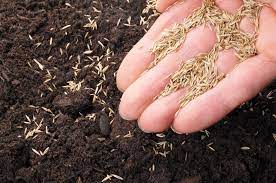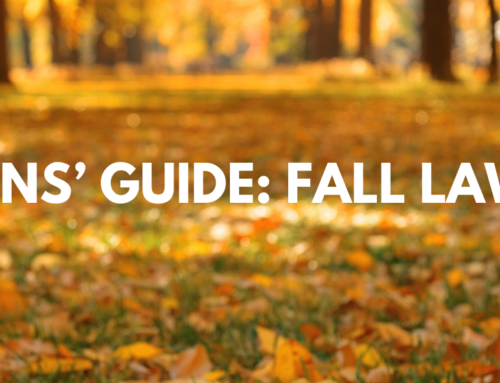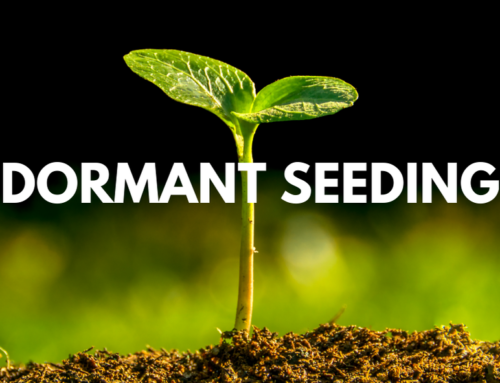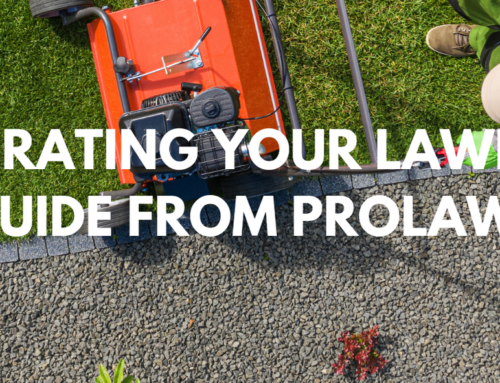When to seed?
The best time to seed, weather-wise and in collaboration with our programs, is late summer and early fall (specifically the last two weeks of August and first two weeks of September). Temperatures are mild enough to not fry the young grass, the soil is still warm enough for seed to germinate, and there is usually regular rain to help the seed germinate.
We advocate first eliminating weeds (which compete with your grass for nutrients) and getting your soil right throughout the season with our programs. You may find you don’t need seeding or at the very least, have your lawn much better prepared for late summer seeding. If you’re determined to seed in the spring: please let us know so we don’t do our crabgrass preventer.
Spring Seeding
Many people try to seed in the spring. Spring seems like a great time with all the rain to help seed germinate and to fill in the spots that are looking rough from the winter. While it is better than mid-summer, here’s why spring seeding won’t be nearly as successful as fall:
-
The crabgrass preventer we put down in the spring and turf grass seed DO NOT get along! The crabgrass preventer also does a great job of preventing turf grass seed from germinating (the seed will not grow).
-
-
We can skip the crabgrass preventer so your seed will germinate but the trade-off is you will have crabgrass. Crabgrass is very expensive to control once it’s germinated compared to preventing it in the first place. We would do a premium “Seed Starter” fertilizer in place of the crabgrass preventer for your spring app.
-
-
-
Grass seed that starts in the spring will have a tough time surviving the hot summer months. Grass needs a healthy root system to get through hot-dry weather. Root systems are developed in the fall. Spring and early summer consists of mostly “top growth” in relation to plants. That grass seed that gets started and seems to be growing great in the spring will likely die in the hot summer months without frequent irrigation (daily or multiple times per day). Grass seed that starts in the late summer or early fall will have all fall to develop a strong root system then all spring to continue establishing itself.
Our crabgrass preventer works very well. It protects your lawn from crabgrass for 4 months. That is also how long the wait period is to seed.
There’s a way to have your cake and eat it too with spring seeding. It’s also the best way to seed anytime! Mix grass seed with some fresh black dirt and spread the combination over the areas needed. The seed will germinate in the fresh dirt. Our crabgrass preventer will have created it’s barrier in your lawn’s soil but will not effect the new soil you spread.
Grass “patch” products also accomplish this. These are the products that mix seed with some type of processed newspaper or other material. The down side to the “patch” products is the seed/price ratio is extremely low compared to buying a bag of seed and a bag of black dirt.
If seeding a large area, consider aerating first. This creates excellent seed-to-soil contact for better germination.
What seed to buy? and how much?
We recommend buying grass seed that comes in fabric bags. It is typically grown locally and will have more success with our climate. It is allowed to breath in the bag as opposed to the sealed plastic bags that come from who knows where/when and sit on the shelves of the big box stores. Seed should be used within a year of purchase. Do not store it where it will freeze/thaw or get damp.
I have no affiliation with Spikes except that we buy our products there.
As for how much seed to buy, the general guideline when over-seeding an existing lawn is to use 3 to 4 pounds of seed per 1,000 sq ft of turf. If seeding bare turf, it’s pretty safe to double that amount. A pretty typical residential lawn is about 12,000 sq ft which would call for 36 to 48 lbs of seed for over-seeding; so buy a 50 lb bag. Spread it lighter than you think to make sure you get all the areas then go over the areas that need it most again to use up the bag.
Watering (The single most important part of seeding)
Here’s what to do to get the most seed to germinate and survive:
-
For the first two weeks: water two or three times daily for up to five minutes each time (the goal is to keep the soil continually damp without washing the seed away – this is what seed needs to germinate). I usually just use a watering can for this.
-
For the following (third) week, water daily for 15 minutes (this helps the seed that germinated establish it’s root system).
-
After those three weeks, maintain normal watering as you would to maintain a healthy lawn. You need to stay a bit more vigilant with newer grass for a few weeks. Your established lawn may just go dormant without enough water but newer grass will simply die and not come back – don’t waste all that effort you put in so far! Click here to learn about general watering practices for your lawn.





